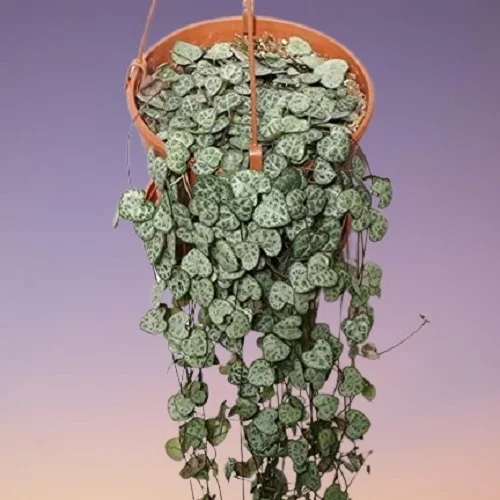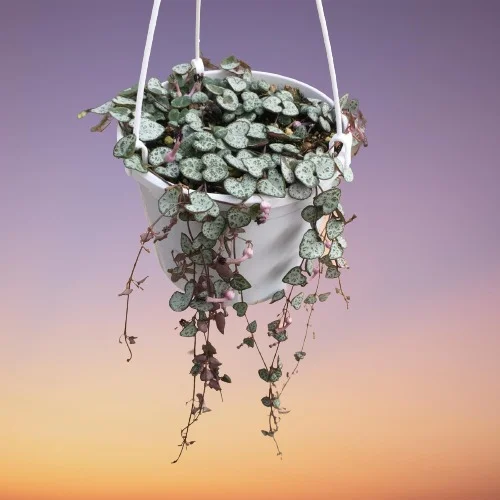12 Reasons Why String of Rubies Plant (Othonna capensis) is Dropping Leaves
Some links in this post may be affiliate links
String of Rubies Plant may lose it leaves due to incorrect watering, extreme temperatures, too little light, exposure to hot direct sunlight, improper feeding, poor soil quality, pests and diseases among others.
Othonna capensis grows best in very bright light with at least 6 hours of sunlight, average warmth of 20-270C, moderate humidity of 50-55% and moderately moist, fertile, well-drained, succulents soil coupled with two feedings in the growing season. Read more on how to grow and care for String of Rubies Plant.
If the growing conditions are wrong, Othonna capensis may begin to lose its leaves. Here are 12 reasons why String of Rubies Plant may drop leaves and how to solve them.
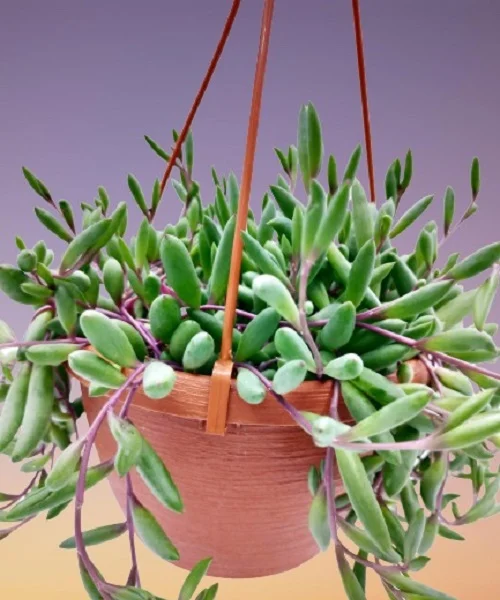
12 Reasons String of Rubies Plant leaves are dropping and remedies
1. Pest Infestations
String of Rubies Plant is prone to mealy bugs, aphids, scale insects and spider mites infestations which are prevent in very dry growing conditions. These sap-sucking insects attack the new growth from where they suck the plant sap and will cause wilting, yellowing and leaf drop.
Remedies
Regularly inspect your String of Rubies Plant for these pests and take timely control measures. Isolate the affected plant and treat it with neem oil and insecticidal soap as per the manufacturer's instructions.
To minimize pest infestations keep the plant well watered and increase humidity by grouping the plants together or grow the plant in a bathroom or other humid areas in the home.
2. Root-bound Plant
A root-bound String of Rubies Plant is one whose roots have filled the pot which means there is very little soil to hold water when the plant is watered as most of the space is occupied by the roots. This implies that, there is little or no water for the plant to take up to the leaves. Theerefore, the leaves lose their stiffness, they wilt and begin to drop.
Remedies
Check the bottom of the pot, if you find roots growing through the drainage hole, repot your String of Rubies Plant into a pot one size larger than the current one.
You may divide the plant into several sections and plant these sections in individual pots to propagate new plants. Ensure that the pot has a drainage hole and that the soil is loose and well-drained to prevent it from getting soggy. Check out these succulents pots on Amazon.
3. Improper Feeding
Overfeeding your String of Rubies Plant will cause the roots to die due to fertilizer burn. When the roots die, they cannot take up nutrients and water required for photosynthesis.
Underfeeding it implies that the plant is not getting enough nutrients need for growth and energy. Without, adequate food for growth and energy, the plant will begin to lose its leaves to save energy.
Remedies
Feed your String of Rubies Plant twice during the growing season with a balanced, liquid fertilizer for a lush growth. Take care not to overfeed the plant by following the manufacturer's recommendations on the label of the plant food
Do not feed in the cold season as growth is reduced and feeding at this time can result in fertilizer burn, yellowing leaves, leaf drop and eventual death of the plant.
Flush out accumulated salts from the soil regularly by running a stream of water through the soil until it comes out through the drainage holes and repeat the process several times. Learn how to feed houseplants.
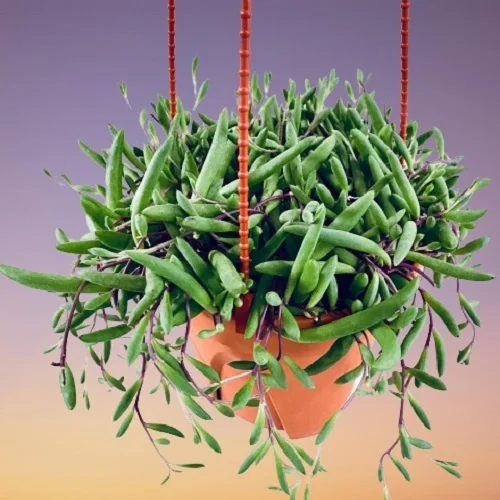
4. Poor Quality Soil
If the soil is of poor quality it does not drain easily and therefore it easily becomes compacted or soggy which can negatively impact the growth of the plant.
Othonna capensis requires loose, free-draining, succulents soil that does not hold excessive amounts of water. Soggy soil can lead to root-rot which is characterized by yellowing, leaf drop and eventual death of the plant.
Remedies
Grow your String of Rubies Plant in good quality, succulents potting soil that is loose, well-drained and rich in organic matter.
5. Root-rot Disease
String of Rubies Plant is prone to root-rot disease. Root-rot disease is prevalent in soggy soil. The disease is characterized by wilted, discolored leaves, corky swellings under the leaves and leaf drop.
When the soil is soggy, too much water reduces oxygen concentration in the soil which causes the roots to die. Once the roots die, they cannot take up water and nutrients to the leaves. The leaves begin to wilt, turn yellow and eventually drop.
Remedies
Slip your String of Rubies Plant out of its pot and inspect the roots. Brown-black mushy roots indicate root-rot, trim them off and treat the healthy roots with a fungicidal solution.
Disinfect the pot with the fungicidal solution or use a fresh pot to repot the plant in fresh free-draining soil. Do not water the plant and keep it dry for some time before you can resume watering.
To prevent the soil from getting soggy, confirm that the pot has a drainage hole and that the soil is free-draining. Reduce watering in the cold season to maintain the soil slightly moist as growth is minimal at this time and the plant does not require a lot of water. Read more on how to treat root-rot in houseplants.
6. Too Little Light
Adequate light is needed for making food that is required for energy and growth. Insufficient light implies that the String of Rubies Plant cannot make enough food for energy and growth. In an attempt to save energy, the plant begins to drop its leaves. This way, it saves the available energy for the vital functions to stay alive.
Remedies
Cutback the bare stems to rejuvenate growth and move the String of Rubies Plant to a brighter spot where it will receive bright light with 6-8 hours of morning or late afternoon sunlight. If you do not have adequate lighting in your home, you may instal a grow light to supplement it. Check out these full spectrum grow lights on Amazon.
Rotate the pot regularly to ensure that the plant receives light on all sides for uniform growth and prevent lopsided growth. Check out this guide on understanding light for houseplants.
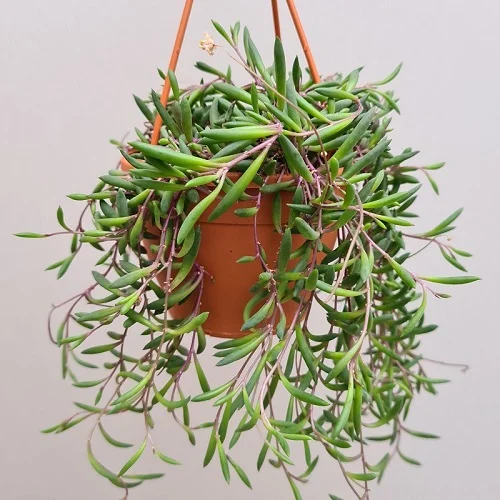
7. Hot Direct Sunlight
Exposing a String of Rubies Plant to hot direct sunshine can cause dehydration and sunscorch which may result in wilting, leaf drop and eventual death of the plant if it is not corrected.
Remedies
String of Rubies grows best under bright light with 6-7 hours of morning or late afternoon sunshine. Keep it away or protect it from hot midday sunshine by instaling a light curtain to filter the light.
If you need to take your plant outdoors, do not expose it to hot direct sunlight before acclimating it. Gradually expose it to a little brighter light every day over a period of 2 weeks to acclimate it.
8. Underwatering
Underwatering your String of Rubies Plant means that there is very little moisture in the soil. As such, the plant cannot take up nutrients and water needed for photosynthesis to the leaves. Therefore, since the plant does not get enough food for growth and energy, it begins to lose its leaves to save energy.
Remedies
Insert your index finger into the top 2-3 inches of soil and feel the soil between your fingers. If it feels dry, thoroughly water your String of Rubies Plant immediately until water comes out through the drainage holes.
Thereafter, water the plant liberally during the growing season while allowing the top 2-3 inches of soil to dry out between waterings. Decrease watering in the cold season as growth is reduced at this time but do not allow the soil to dry out completely. Learn more on how to water houseplants the correct way.
9. Overwatering
Overwatering your String of Rubies Plant results in soggy soil (excess water in the soil). Too much water in the soil reduces the oxygen concentration in rootzone and this causes the roots to die.
When the roots die, they cannot take up water and nutrients needed for the food making process. Therefore, the plant does not make enough food for growth and energy. In a bid to save energy, it begins to lose its leaves.
Remedies
Check the state of the soil; insert your index finger into the top 2-3 inches of soil. If the soil feels wet, the plant is overwatered. Stop watering it and repot it in fresh soil.
To prevent the soil from getting soggy in the future, ensure that the pot has a drainage hole and that the soil is free-draining. In addition, lessen watering the plant during the cold season to maintain the soil barely moist as growth is minimal at this time.
10. Too Cold Water
String of Rubies Plants are native to the tropical regions where the temperatures remain constantly warm through out the year. Therefore, constantly watering your plant with too cold water will shock the plant. This will result in reduced growth which causes the plant to begin losing its leaves and eventually die.
Remedies
Water your String of Rubies Plant with water that is at room temperature and avoid watering with too cold water for a prolonged period of time to prevent cold shock.
11. Extreme Temperatures
String of Rubies Plant requires an average temperature of 20-270C to thrive. If the temperatures are extreme; either too high or too low (outside the above range) they will affect the normal functioning of the plant systems.
Too high temperatures will cause excessive loss of water leading to wilting and leaf drop. At too low temperatures, the plant stops growing and begins to die. Leaf drop is one sign of a dying plant.
Remedies
Keep your Othonna capensis away from cold drafts like drafty winds, air conditioning, open doors and others to avoid low temperatures or place it in a warmer place.
Ensure that the plant is not near hot surfaces, hot vents and other hot areas to prevent extremely high temperatures. Maintain an average warmth of 20-270C. Usually, a room temperature that is comfortable for you is ideal for your plant. Check out this guide on understanding temperature for houseplants.
12. Age of the leaves
As your String of Rubies Plant leaves mature, the older leaves begin to turn yellow and die. Therefore, do not be alarmed, if a few leaves turn yellow and drop as this is a natural process.
You liked it? Share on social media.
Related Content
Amazon Associates Disclosure
Homeplantsguide.com is a participant in the Amazon Services LLC Associates Program, an affiliate advertising program designed to provide a means for sites to earn advertising fees by advertising and linking to amazon.com.



